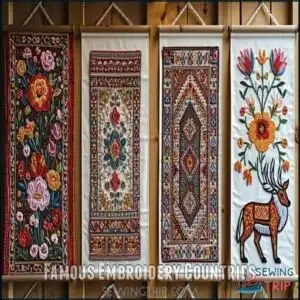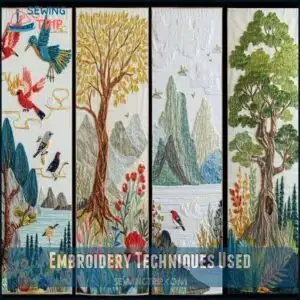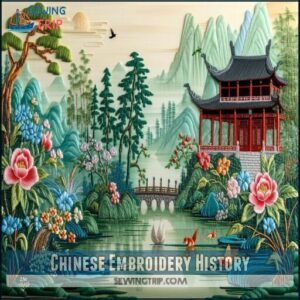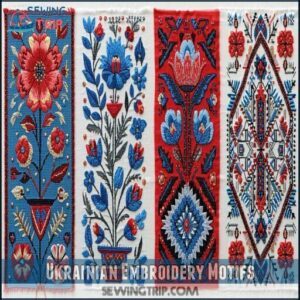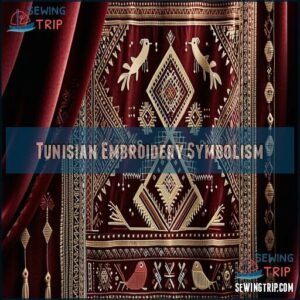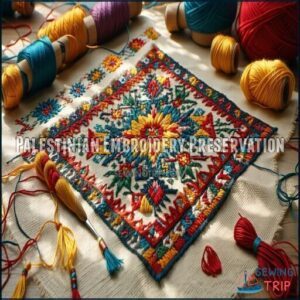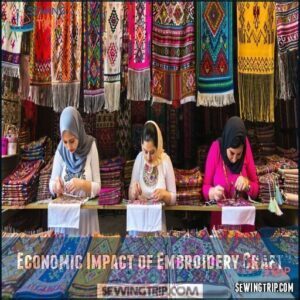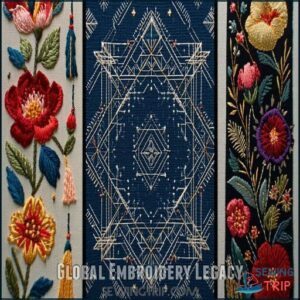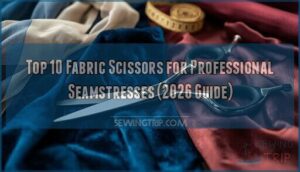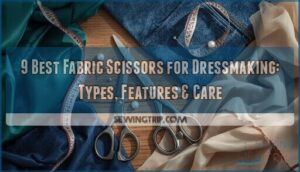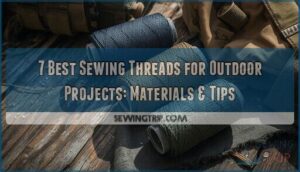This site is supported by our readers. We may earn a commission, at no cost to you, if you purchase through links.
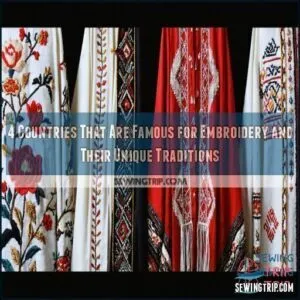
Their vibrant floral patterns aren’t just decoration—they tell stories of heritage and family.
Next, China stuns with intricate silk embroidery, where even a tiny strand is art in motion.
Tunisia’s gold-thread work feels like wearing royalty, blending North African flair with history.
In Palestine, embroidery isn’t just a craft—it’s identity stitched into fabric, with bold geometric designs making powerful cultural statements.
Each country has its own spin on this timeless art, proving embroidery’s not just about thread—it’s about tying generations together.
Fascinating, isn’t it?
Table Of Contents
Key Takeaways
- You’ll see Ukraine’s colorful "Vyshyvanka" embroidery telling stories of heritage and protection with intricate regional patterns and vibrant colors.
- China’s silk embroidery is a masterpiece of craft, with styles like Suzhou and Hunan showcasing lifelike art and bold designs rich in tradition.
- Tunisia’s gold-thread embroidery blends elegance and history, with couching stitches and geometric motifs shining on luxurious velvet.
- Palestinian "Tatreez" stitches culture and identity into fabrics, with symbolic geometric designs preserving history and resilience.
Famous Embroidery Countries
You’ll find some of the world’s most stunning embroidery in countries where culture and craftsmanship go hand in hand.
From China’s intricate silk threads to Palestine’s symbolic patterns, each tradition tells a unique story stitched into fabric.
China’s Embroidery Legacy
Chinese silk embroidery is a mesmerizing blend of artistry and tradition.
Rooted in dynastic influences, it showcases stunning Silk Thread Art through evolving regional styles.
You’ll admire these four iconic styles:
- Suzhou Embroidery: Famous for intricate, lifelike symbolic motifs.
- Hunan Xiang Embroidery: Masterful animal designs in clean, minimal spaces.
- Guangdong Yue Embroidery: Lavish gold threads create wedding masterpieces.
- Sichuan Shu Embroidery: Bold floral patterns with vibrant, modern adaptations.
This craft preserves China’s rich cultural heritage.
Ukraine’s Traditional Embroidery
In Ukraine, embroidery isn’t just decoration—it’s a heartbeat of tradition.
The Ukrainian Vyshyvanka, with its intricate stitches and vibrant colors, carries stories of culture and protection across centuries.
Each regional pattern reflects a unique identity.
| Region | Color Palette | Symbolic Meanings |
|---|---|---|
| Western | Red, blue, yellow | Fertility, strength |
| Northern | Red, blue, black | Protection, harvest |
| Eastern | Blue, green, white | Sky, earth, purity |
Historically, these protective designs were thought to repel evil spirits.
Today, Vyshyvanka symbolism thrives in both modern adaptations and traditional clothing, blending heritage with contemporary fashion.
Wearing embroidery isn’t just stylish—it’s a proud nod to Ukrainian heritage and cultural identity, connecting generations.
Tunisia’s Gold Thread Embroidery
How does Tunisia blend art and culture so seamlessly? Through its dazzling gold thread embroidery, an enduring symbol of Tunisian craftsmanship.
From wedding tunics to ceremonial cushions, this art form epitomizes both elegance and heritage. Tunisian goldwork relies on couching stitches, securing gold and silver threads onto luxurious velvet materials or silk.
The designs often incorporate geometric motifs rooted in Tunisian symbolism, such as the Hand of Fatima or fish patterns. A key consideration is to guarantee thread color fastness to maintain the embroidery’s brilliance.
Key Elements:
- Couching Stitches ensure precision and durability.
- Velvet Materials provide a rich, vibrant foundation.
- Geometric Motifs add cultural depth and visual appeal.
- Thread Fastness preserves brilliance across generations.
This delicate craft reflects Tunisia’s dedication to preserving traditional techniques while showcasing cultural reflection.
Palestine’s Cultural Embroidery
From gold threads in Tunisia, let’s hear about Palestine’s embroidery—a tradition that stitches culture and identity beautifully into fabric.
Palestinian embroidery, or tatreez, isn’t just decoration—it’s storytelling in thread.
Featuring Tatreez stitches and Tahriri couching, this craft combines symbolic motifs like the Hand of Fatima with vibrant, geometric designs that feel alive.
Each piece reflects deep cultural heritage, connecting past and present.
Different regions in Palestine add their own flavor—floral patterns and symmetrical borders showcase rich regional variations.
Women handcraft these designs on traditional garments or handwoven fabrics, often blending silk, cotton, or linen threads with skill and care.
More than fabric, Palestinian tatreez is emotional history—a treasure passed down generations.
Through heritage preservation, you’re not just seeing art.
You’re witnessing stories, culture, and identity stitched into existence.
Embroidery Techniques Used
You’ll find that each country’s embroidery techniques are as unique as their histories, blending art with tradition in fascinating ways.
From silk threads to goldwork, these methods tell stories and preserve culture with every stitch, showcasing the culture in a beautiful display of craftsmanship.
Chinese Silk Thread Manipulation
Silk embroidery transforms plain fabric into visual poetry with unmatched artistry. In China, silk thread quality plays a huge role in achieving intricate designs. Artists use color blending techniques to create lifelike flowers, birds, and other motifs.
Here’s how experts handle this craft:
- Separate threads scrupulously for detail and smooth stitching.
- Employ stitch density effects to add depth and texture.
- Adapt historical motif evolution for timeless beauty.
These embroidery techniques create masterpieces, from intricate Suzhou works to bold Sichuan patterns, blending tradition with modern applications. A wide range of vibrant thread selections are available for these projects.
Palestinian Cross-Stitch Variations
Tatreez embroidery brings Palestine’s cultural heritage to life through stunning CrossStitch techniques.
Gaza Cross-Stitch showcases geometric patterns, Bethlehem styles highlight intricate starburst designs, and Hebron patterns feature bold floral motifs—all representing rich traditions.
Regional colors, like deep reds and striking blues, create an unforgettable contrast while carrying symbolic motifs that tell stories of identity and resilience.
You can even purchase Palestinian patterns online.
Each piece reflects its origin, making every stitch a nod to Palestine’s vibrant history. Whether it’s a blouse or wall art, Palestinian CrossStitch immortalizes heritage as both art and storytelling in timeless, meaningful designs.
Ukrainian Floral Stitch Patterns
Celebrating artistic roots, Ukraine’s embroidery features vibrant floral patterns on linen and silk, blending heritage with beauty.
These creations, rich in floral symbolism, thrive through regional variations, offering charm and meaning.
One can even use basic embroidery stitches to create similar patterns.
- Showcase cultural heritage through nature-inspired art.
- Combine modern adaptations with timeless motifs.
- Support stitch evolution for diverse fabric styles.
- Feature bold designs with emotional depth.
- Honor Ukrainian heritage through exquisite craftsmanship.
Tunisian Couching and Goldwork
Tunisian embroidery captures your heart with its shimmering gold thread and couching stitches, blending beauty with cultural heritage.
From floral motifs in Nabeul to vibrant Sahel scenes, each design resonates with history and artistry. Mastering couching stitch types requires precision tools and skilled hands, especially for anchoring goldwork on velvet fabric.
Tunisia’s embroidery roots showcase geometric pattern origins and historical Berber influence. You can even find beautiful examples of authentic crafted products online.
Here’s a closer look:
| Feature | Details | Significance |
|---|---|---|
| Gold Thread Sourcing | Locally or imported | Guarantees vibrant, lasting sheen |
| Couching Stitch Types | Varied, intricate | Adds texture and durability |
| Velvet Fabric Choice | Luxurious foundation | Elevates aesthetic appeal |
| Geometric Pattern Origins | Berber-inspired | Reflects Tunisia’s rich legacy |
| Cultural Heritage | Woven into designs | Preserves national identity |
Country Specific Embroidery
You’ll find that embroidery isn’t just about stitching patterns; it’s a way countries tell their stories.
From vibrant Ukrainian motifs to Tunisia’s golden threads, each tradition connects artistry with culture in fascinating ways, showing how embroidery is a unique form of expression that highlights cultural heritage.
Chinese Embroidery History
Chinese embroidery traces its roots back over 2,000 years, shaped by Imperial patronage and the Silk Road influence.
It flourished with stunning artistry and symbolism evolution.
- Suzhou Embroidery: Silk threads create lifelike scenes.
- Regional Variations: Styles reflect China’s vast diversity.
- Song Dynasty China: Known for intricate masterpieces.
- Dynastic Embroidery Styles: Prosperity, health, and elegance radiate through each pattern.
Embroidery in China showcases unmatched craftsmanship and cultural storytelling.
Ukrainian Embroidery Motifs
Ukraine’s embroidery motifs are a vivid way to explore its history, creativity, and culture.
Each stitch holds meaning, blending motif symbolism, regional variations, color significance, and timeless stitch techniques.
Here’s how regions bring embroidery to life:
- Central Ukraine: Soft blue tones with flowing floral patterns, mirroring tranquil landscapes.
- Western Ukraine: Striking contrasts—bold reds, blacks, and blues create dynamic geometric designs.
- Lemko Style: Crisp red-and-blue motifs, marked by symmetry and linear style.
- Bukovina: Shimmering metallic threads, paired with traditional symbolic motifs and glistening beads.
Embroidery isn’t just tradition; its modern interpretations highlight Ukraine’s enduring artistry while celebrating its unique culture!
Tunisian Embroidery Symbolism
Tunisian embroidery isn’t just art—it’s storytelling with threads.
Fatima’s Hand, fish motifs, and geometric patterns all carry deep meaning, offering protection and reflecting cultural identity.
With gold threads dancing on lush velvet, every stitch showcases symbolic motifs tied to history.
The thread significance goes beyond decoration—each piece celebrates life, often blending embroidery symbolism with intricate designs that honor Tunisia’s traditions.
It’s elegance woven with purpose.
Palestinian Embroidery Preservation
Palestinian embroidery, or tatreez, weaves stories into every stitch, reflecting cultural identity and regional pride.
Tatreez captures heritage in every stitch, stitching life’s stories and identity into timeless Palestinian fabric artistry.
Passed through generations, it’s a bridge between tradition and modernity. Efforts like Tatreez Revival and youth engagement promote heritage preservation while teaching embroidery’s value.
Workshops foster economic sustainability, where design evolution breathes new life into old patterns. In Palestine, tatreez is more than art—it’s history you can wear, preserving cultural heritage one colorful thread at a time for future generations, and promoting heritage preservation.
Embroidery Cultural Significance
Embroidery isn’t just decorative; it’s a cultural treasure that connects generations and tells stories through every stitch.
You’ll find it woven into traditions, celebrations, and even livelihoods, proving its timeless importance worldwide.
Embroidery in Traditional Celebrations
Embroidery in celebrations isn’t just decoration—it’s a storyteller. It weaves cultural identity into life’s biggest moments.
- Wedding Attire: Indian brides glow in shimmering gold-threaded ensembles, symbolizing prosperity and love.
- Festive Motifs: Mexican festival costumes burst with bold colors, celebrating joy with iconic designs.
- Ritual Garments: Ukrainians cherish their embroidered tablecloths and attire, threading heritage into every knot.
- Religious Symbols: Palestinian ceremonial clothing features meaningful embroidery, blessing wearers with protection and faith.
Every stitch transforms fabric into a canvas for tradition and celebration!
Passing Down Techniques Through Generations
Passing down embroidery techniques is like weaving threads of history into the future. Across cultures, this tradition nurtures Family Embroidery Lineage, keeping heritage alive.
Imagine an Indian grandmother skillfully teaching intricate temple embroidery or a Ukrainian village elder guiding apprentice training programs in bold patterns. Hands-on learning thrives in these settings.
Community Workshop Initiatives, like those in Palestine, mentor younger generations in cross-stitching durable designs. Meanwhile, digital technique preservation is making its mark, ensuring these skills adapt to modern times.
Generational Skill Adaptation is key. Families and communities pass on their expertise through storytelling, laughter, and practice. It’s not just about embroidery; it’s about building connections, fostering belonging, and ensuring that culture isn’t just remembered—it’s celebrated with each stitch.
Embroidery as a Form of Storytelling
Every stitch weaves a story, turning fabric into living tales.
Through motif narratives, people have shared embroidered history, reflecting cultural symbolism and personal expression.
Across the globe, textile tales depict life’s milestones—like marriages or harvests—perfectly blending beauty with meaning.
Embroidery as storytelling isn’t just art; it’s cultural transmission in its finest form.
Whether through intricate patterns or vibrant embroidery symbolism, traditions thrive as craftspeople pass down techniques, preserving identity and history in ways words never could.
It’s a versatile craft that uses needle and thread to create designs, which is a form of personal expression and cultural heritage.
Economic Impact of Embroidery Craft
In the context of the economic impact of embroidery, this craft isn’t just decorative—it’s transformative. It fuels artisan livelihoods, shapes global markets, and celebrates cultural heritage.
- Craft employment empowers women worldwide, especially in Palestinian cooperatives, where embroidery sustains families.
- In China, luxury embroidery taps elite markets, with artisans earning impressive incomes while preserving traditions.
- Tourism revenue and export income thrive as Ukrainian villages showcase handmade pieces at fairs, capturing international collectors’ hearts.
Embroidery’s global legacy is woven with prosperity!
Global Embroidery Legacy
When you explore the global embroidery legacy, you uncover rich traditions shaped by history and culture.
Each stitch tells a story of creativity, craftsmanship, and the preservation of heritage that connects generations.
Evolution of Embroidery Techniques
It’s fascinating how embroidery connects the ancient with the modern—a real "thread of life." As you explore embroidery evolution, you’ll see how stitches went from hand-spun simplicity to precise artistry.
Thanks to tool development and material innovation, methods have embraced design evolution while keeping roots intact. Think about the leap from silk and wool to today’s durable blends or how digital embroidery shapes today’s patterns.
| Evolution Aspect | Then | Now |
|---|---|---|
| Stitch Adaptation | Basic, symbolic motifs | Detailed, dynamic designs |
| Material Choices | Pure silk, wool | Silk blends, synthetics |
| Tools | Handmade needles | Precision equipment |
| Patterns | Locally inspired stories | Global collaborations |
Through it all, embroidery techniques reflect enduring cultural charm.
Unique Embroidery Styles Across Nations
Embroidery showcases the creativity and history of each nation, blending Style Evolution and Regional Influences into stunning designs.
You can see this in Ukraine’s vyshyvanka, where Material Choices like linen highlight symbolic patterns or stitches protecting against bad vibes—who wouldn’t want that? In China, silk thread brings vibrancy to delicate motifs, while Japan’s sashiko turns simple Stitch Innovation into art.
Mexico’s Tenango bursts with bold colors and fun designs tied to Global Trade, ensuring embroidery stays globally cherished.
- Ukraine: Symbolic vyshyvanka.
- China: Vibrant silk embroidery.
- Japan: Minimalist sashiko.
- Mexico: Bold Tenango designs.
Embroidery as a Form of Art
Embroidery isn’t just crafting with thread; it’s an artistic expression that transforms textiles into stories.
Across the globe, artists elevate embroidery, blending traditional techniques with creative innovation to spark emotions and preserve cultural narratives.
Think of embroidery as painting, but with needles and thread. It carries history and meaning, rather than being solely for decoration.
Here’s how embroidery thrives as an art:
- Stitches and colors act like a palette, shaping vivid patterns.
- Each work reflects personal inspiration or cultural roots.
- Artists fuse embroidery mediums like silk or linen with modern twists.
- Understanding how to use an embroidery hoop properly is key to a successful project.
- Textile art bridges ancestral embroidery traditions from nations like China with renewed expression.
It’s like storytelling, one stitch at a time.
Preserving Cultural Heritage Through Embroidery
Embroidery stitches together the past and future, blending Artistic Identity with Community Empowerment.
Through Heritage Preservation, every thread safeguards cultural roots. Workshops and homes brim with hands-on learning, ensuring Generational Knowledge keeps Embroidery Preservation alive.
You see patterns tied to Cultural Symbolism passed down like precious heirlooms, celebrating Embroidery’s Cultural Significance.
Material safeguards protect textiles, preserving both durability and beauty. From inspiring artisans to supporting Economic Sustainability, it’s a vibrant legacy woven into everyday life.
Each piece tells a story, honoring traditions while stitching new chapters for tomorrow.
Frequently Asked Questions (FAQs)
Which countries are known for embroidery?
China, India, Japan, Ukraine, and Mexico are famous for their embroidery traditions.
Each country showcases unique techniques, from China’s elaborate silk threadwork to Ukraine’s symbolic patterns, blending artistry, heritage, and cultural identity beautifully.
They blend cultural identity in a beautiful way.
When did embroidery start in Ukraine?
Imagine this: centuries-old stitches preserving culture.
Ukrainian embroidery dates back thousands of years, emerging with the Trypillian culture (around 4,000 BC).
It wasn’t just decoration; it symbolized protection, identity, and heritage, stitching stories onto fabric.
Is embroidery still popular today?
Absolutely, embroidery remains a thriving art form today.
From personalized gifts to high-fashion runway designs, it’s everywhere.
You’ll find it blending tradition with modern aesthetics, making it perfect for expressing creativity and preserving culture.
What kind of designs are common in Ukrainian embroidery?
Did you know Vyshyvanka patterns date back centuries?
You’ll find intricate geometric designs, floral motifs, and symbols like stars and trees.
Each design isn’t just decorative—it reflects regional history, protects against misfortune, and celebrates identity!
Where did embroidery come from?
Embroidery dates back over 30,000 years, with early evidence from ancient China and Egypt.
Cultures worldwide embraced it for decoration and storytelling, turning simple stitches into art, blending utility, beauty, and cultural identity, making it a form of storytelling.
Are embroidery traditions still relevant today?
Ever wonder why embroidery still matters?
It’s more than decoration—it’s storytelling, tradition, and expression.
You see it in fashion, art, and culture, blending history with modern trends, proving its timeless relevance worldwide.
Which country is known for embroidery?
You’ll find countries like India, China, and Ukraine standing out for their rich embroidery traditions.
Each offers stunning techniques—from India’s regal Zardozi to Ukraine’s symbolic Vyshyvanka—celebrating culture while keeping artistry alive.
What are the four famous embroidery?
Four famous embroidery styles are Suzhou from China with silk artistry, Palestinian Tatreez featuring symbolic stitches, Ukrainian Vyshyvanka blending patterns with culture, and Indian Zardozi elevating metallic threads.
Each represents heritage, tradition, and craftsmanship.
Which place is famous for embroidery?
Needle and thread unite cultures worldwide, but places like Suzhou, China, for silk threads; Lucknow, India, for Chikankari; and Ukraine for Vyshyvanka stand out.
Their techniques showcase storytelling, heritage, and sheer artistry.
What are the 4 types of Chinese embroidery?
Chinese embroidery boasts four iconic styles: Suzhou with intricate silk work, Hunan’s vibrant animal designs, Guangdong’s gold-thread grandeur, and Sichuan’s bold floral patterns.
Each embodies China’s rich history, celebrating art through regional diversity and skill.
Conclusion
It’s no coincidence that embroidery brings history to life in unexpected ways.
These 4 countries that are famous for embroidery—Ukraine, China, Tunisia, and Palestine—each offer more than just beautiful patterns.
You’re not just seeing threads; you’re seeing generational stories, cultural pride, and stunning techniques.
From Ukraine’s vibrant florals to Tunisia’s luxurious goldwork, every region adds its own flair.
So next time you spot embroidery, you’ll know it’s much more than decoration—it’s a tapestry of heritage.

